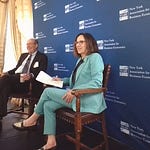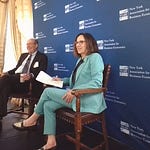Dennis Lockhart is the former president of the Federal Reserve Bank of Atlanta, so he is clearly in the Been There Done that Camp when it comes to assessing where Fed is policy is at any point in time and where it may be heading, and in fact where it often does go.
There’s no doubt that the Fed at this week’s meeting is dead set on kicking off what will be a series of rate cuts as it aims to achieve a soft landing where inflation keeps heading toward its 2% target and the labor market remains on solid footing. What’s not clear is if the Fed will do a measured 25bps rate cut now as many economists had expected it would for much of this year, or it will opt for the 50bps cut that many have called for as they see a weakening labor market that could lead to a severe slowdown if not recession.
” I think you can make a case for either twenty-five or fifty basis points but… in my opinion they will stay with the so-called normal rate cut which would be twenty-five, he says.
”In situations like this where a case can be made for either policy action, in my experience, often the chair has sort of the decisive influence,” Dennis explains. “Even though it's a consensus committee, if it comes out kind of mixed opinions, Chair Powell likely will say, my preference is to do this or that, and he could sway the committee in one direction or another.
”We don't have a great indication of whether he prefers 25 0r 50, Dennis adds.” He said some strong things in Jackson Hole (at the Kansas City Fed’s Symposium) but really has there's been no indication in his rhetoric of whether he's going to stay with sort of the tried and true twenty-five or a stronger action coming out of the blocks with with fifty’s.”
“So, you know, I won't be surprised if it's 50, but I believe they will do 25,” he concludes.
Many proponents of a 50 bps rate cut see the danger see the economy going into recession if the Fed does not do the jumbo cut. Dennis does not.
”I don't think you can make that case. The economy, when you take a composite view of all the data appears to be quite healthy and continuing to motor along with growth.
”I looked at the Atlanta Feds GDP Now yesterday. That's for this particular quarter. And since we're in the month of September, the data, a lot of data have accumulated and it makes the GDP Now a useful tool. And it shows 2 .5 % annualized growth in the third quarter. So we're seeing continued above trend growth.”
He adds that the latest retail sales data were pretty solid, no major departure from the past. “So even though there are some signs of at the low income echelons of some consumer weakening. Overall, the consumer motor of the economy continues to be healthy.”
” So I don't think you can make the case that we're headed toward a recession. And for that reason, I think the 25 is probably the better choice.”
But Dennis can why the Fed could decide to do the bigger cut - and it’s all about the labor market.
”If you were to make the case for 50, you would point to the fairly brisk slowing of the employment markets, the revisions maybe that we saw in the last two or three months give some pause that we are misreading the health of the employment markets and therefore and you could argue that if if your objective is to protect the employment situation, they could have actually moved in July. That would have been a justifiable move, so some amount of saying they're slightly behind the curve could be argued.
“So, you know, I can see both ways. This is a push -me -pull -you kind of situation, but to your question about recession, It doesn't appear to be in the cards at the moment.”
We cover a lot more ground in this interview. Dennis sees current policy at a sufficiently restrictive enough to level now to keep pushing inflation down, albeit gradually and possibly with some pauses, as the Fed embarks on a steady if gradual rate cut path.
When it comes to the new Dot Plot that shows us how many or how few rate cuts the 19 members of the SOMC expect this year, he says there may be a couple of the more hawkish Fed officials that see a total only one or two cuts this year. But he does not expect a dissent from any of them even if the voting members opt for a 50 bps cut.
So dive in, hear and see what Dennis has to say. He’s a great explainer, A clear thinker. Agree or disagree you will understand the arguments on both sides of the Fed policy path debate when you do.













Share this post